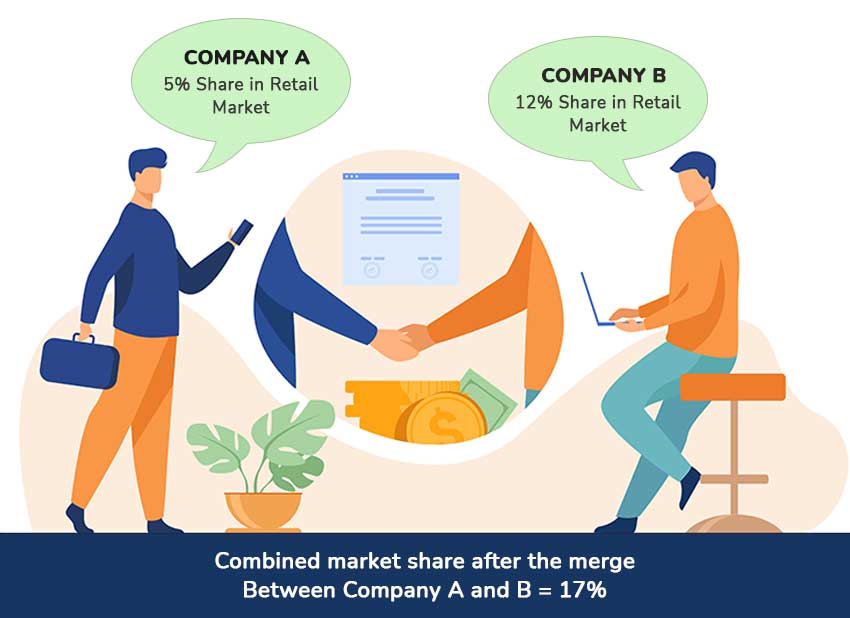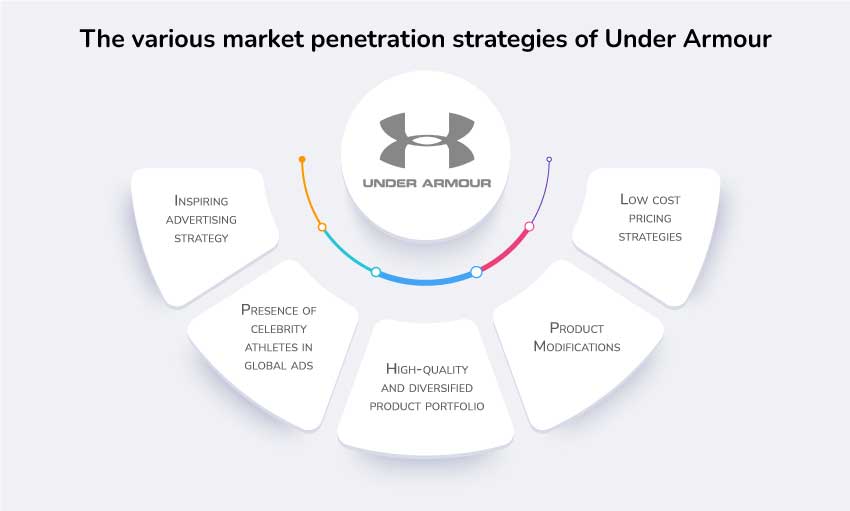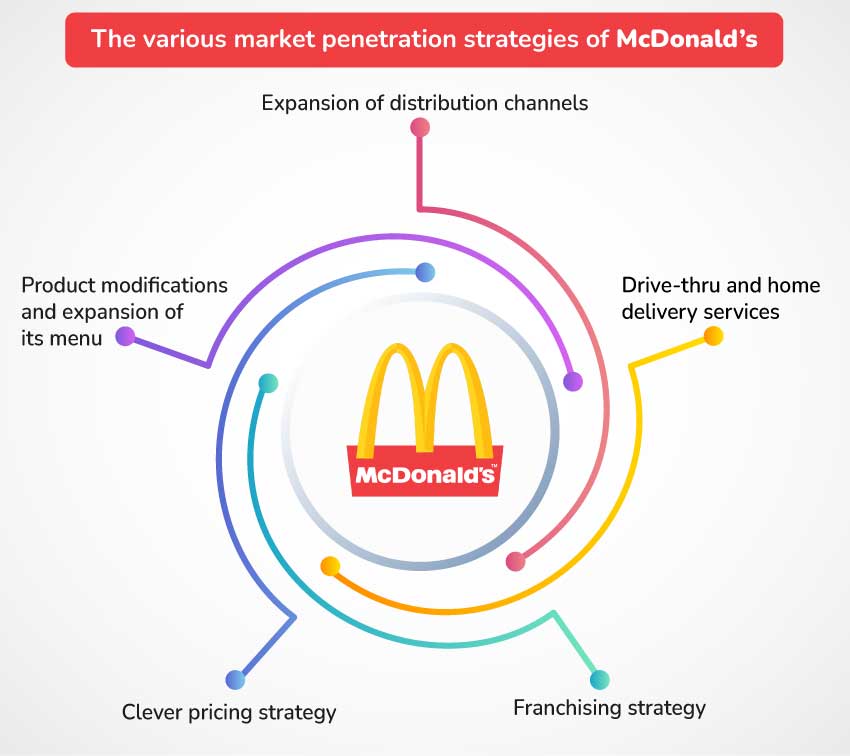“Penetration seems a kind of inspiration; it gives one an idea of prophecy” – LORD GREVILLE
Table of Content
Overview
We all know that business organizations are required to implement diverse strategies to improve their market share and competitive position in the market. But, do you know what we mean by these strategies? What are different strategies being implemented by business organizations to streamline growth? As per the Ansoff Matrix or the market/product expansion grid, there are four crucial strategies that businesses can undertake for growth and advancement. These strategies include the following.
- Market Penetration
- Product Development
- Market Development
- Diversification
In this thoughtful and pragmatic blog, we lay emphasis on the market penetration strategy for the advancement of a firm. The blog discusses the intricacies of the market penetration strategy in detail to help you understand the importance, best practices, and benefits of the market penetration strategy. So, without further ado, let us delve deeper into the comprehension of the market penetration strategy.
What is the market penetration strategy?

Market penetration strategy is one of the business strategies illustrated in the Ansoff Matrix given by H. Igor Ansoff. The market penetration strategy is the opposite of the diversification strategy for business growth and can be defined as the pursuit of a business organization to augment its market share in an existing market with existing products.
The aim is to attain a larger number of customers, drive higher sales in the market segment, and hence procure a greater market share. It is noteworthy that, under the market penetration strategy, the organization sells the existing products in the existing market.
Let’s take the example of Tesla here for better comprehension. As per research data by Electrek, the market share of Tesla in the US electric car market reached 79 percent by the first half of 2020. As per Experian, the market share of Tesla in 2020 showed a whopping increase of 16 percent in comparison to its share in the US electric car market in 2019. A market penetration strategy is what worked for Tesla to penetrate deeper into the US electric car market. So, this example clearly explains what a market penetration strategy aims to accomplish.
The standout feature of this strategy is the low-risk business growth prospects that it offers. Under this strategy, a company works on gaining more customers and hence a larger market share with its existing products itself in a market that is already familiar to it. Having said that, the risk quotient in a market penetration strategy remains low. It is also interesting to note that market penetration can be defined as both a growth-oriented business activity as well as a measurement.
While market penetration as a business growth activity has already been defined above, as a measurement tool, market penetration evaluates the sales of a specific product relative to the comprehensive estimated market for the given product. This quantitative measure of penetration is expressed in terms of percentage. This is where the market penetration rate comes into the picture. The subsequent section puts forth a thorough elaboration on market penetration rate and its calculation.
Market penetration rate calculation

Market penetration strategy is both an activity as well as a measurement and if the organization is using the market penetration as the measurement, the organization can use the formula to determine how much of the product or service is used by the customers in the market. Now, you must be surprised by the fact that the market penetration strategy can be used as the measurement approach. So, Let’s take a view on how market penetration can be measured?
The market penetration as the measurement can help to assess how much of the product is sold in the market relative to the total estimated market for the product or service. This is also known as the market penetration rate which can be calculated through the use of the following formula-
The formula for the calculation of market penetration rate
The market penetration rate is yielded by the formula-
| Calculation of market penetration rate = | Total Sales | x 100 |
| Total market size |
Now, you must be thinking of when this rate can be calculated. The organization can calculate the market penetration rate at any time but the good rule of thumb is to calculate the Market Penetration rate after every marketing and sales campaign. But, do you know what this rate indicates?
The high market penetration rate of the organization indicates that-
- The organization is an industry leader
- The organization has a well-recognized brand
- The organization has strong brand equity
- The organization has a high sales volume
- The organization has a strong market presence and good visibility in the market
The good market penetration rate in the industry varies from industry to industry but it is essential to consider that the average market penetration rate of the consumer goods industry is 2 to 6 % and that of the business products and services is 7 to 30%. However, you need to be aware of the fact that a good market penetration rate is anything above 9 % and the established businesses have different penetration rates when compared with the market penetration of the new firm.
Let us consider the example of the smartphone industry to look at the market penetration rates of various smartphone manufacturers. According to Statista, Samsung has achieved the highest market penetration rate in the smartphone industry with a market share of 19.2 % followed by the market share of Apple i.e. 15.1 %. At the same point, the market penetration rates of other firms such as Xiaomi, Oppo, Realme, etc. have been found to be very low due to the fact that the established firms have higher penetration rates than the new firms.

However, we need to also consider the fact that the smaller smartphone companies such as Vivo, Oppo, Realme, Lenovo, etc. have the opportunity to increase their market share in the industry by focusing on the quintessential tactics of the market penetration strategy which include lowering down the prices, product improvement, consistency, extension of the distribution channels, etc.
The next section lists the most effective strategies and tactics that need to be undertaken to make market penetration successful and hence attain a larger market share in the existing market. Besides, there is also an elucidation on the significance of each of these tactics and their relevance in adding value to the market penetration strategy initiated by a business.
Tactics for market penetration
While thinking about implementing the market penetration strategy and increasing the market share, the organization is required to consider the ways by which the organization can grow its market share and make its products more appealing to the customers. Let us discuss the main strategies that are adopted by the organizations while implementing the market penetration strategy.
Penetration Pricing
Penetration pricing is one of the foremost tactics that a company needs to take into consideration while working on a market penetration strategy. As a part of its market penetration strategy, a company may be required to readjust or come up with new pricing plans. The approach is simple, businesses need to lower the prices of their products and services in order to win more customers.
A price drop tactic works well for attracting customers that buy a product or service with cost being the biggest factor or consideration. A slightly lower price than competitors can enable a business to attract more customers in the existing market and hence it can yield a competitive advantage. Based on the pricing strategy of the competitors and the changes in the disposal income of consumers, adjustments in pricing plans can be a smart move to make a market penetration strategy work.
For instance, in February 2021, Tesla adjusted its price range and reduced the price of its standard range and long-range variants of Model 3 by USD 1000. As per reports, Tesla brought these price adjustments in response to the launch of the Bolt EV and Bolt EUV models by Chevrolet on 14 February. This is one of the most relevant examples of the price drop in order to gain a competitive advantage over competitors to procure a larger market share.
The following image explains another example of how penetration pricing is adopted by businesses to attract new customers and build a community of loyal customers for capturing a larger market share.

There are other multidimensional merits that penetration pricing can offer. These key advantages include the following.
- Quick acceptance of products among customers
- Enhanced market goodwill
- Increased inventory turnover which is beneficial for vertical supply chain partners
- Lower marginal costs for firms
- Realization of economies of scale
However, there are some drawbacks associated with a lower pricing strategy for better penetration. To make sure that the penetration pricing policies do not create a backlash, the downsides of penetration pricing need to be strategically negated.
The potential downsides of penetration pricing are listed below.
- Lower pricing can potentially deteriorate brand image
- Penetration pricing can trigger price wars leading to lower profitability in the market
- It can lead to lower customer loyalty as penetration pricing attracts customers interested in bargaining
- Penetration pricing invokes the anticipation of permanent low prices among customers
- Penetration pricing can prove to be an ineffective tactic in the longer run
Cost leadership
A cost leadership strategy implies that in order to attract more customers and attain a larger proportion of market share, a company needs to emerge as a leader in its category for low pricing. Under the cost leadership strategy, companies can offer products and services at the lowest possible price without impacting their profitability much.
The key is to reduce costs of marketing, packaging, distribution, and other operational costs to balance the downfall in the costs of products and services. There are multifaceted benefits that are linked to a cost leadership strategy undertaken by firms. Companies that are cost leaders are able to leverage more flexibility and they can also try out new product offerings. The lower cost of products enables such flexibility and to compete with cost leaders, competitors may have no other choice but to incur losses by selling their products lower than their cost price.
In order to become a cost leader, a company can possibly take the following approaches
- Increase in the scale of production
- Adopting a strategy of sourcing raw products
- Improving operational efficiency
- Incorporation of state of the art technological innovations
- Implementation of sustainable business practices
Speaking of examples of cost leaders, RyanAir and Walmart are among the most brilliant examples of cost leadership who have been able to acquire substantial market shares in their category with a cost leadership strategy.
Multi-channel marketing

The prospects of attracting new customers to buy existing products in the ongoing times of high market competition depend significantly on the marketing skills of a business. An enterprise needs to complement its penetration strategy with robust marketing campaigns across various domains and channels. In contemporary times, businesses need to have firm tactics in place for digital marketing in addition to the traditional forms or conduits of marketing. By marketing their existing products in smart and appealing ways, companies can make their brand and products more visible offline as well as online.
Speaking of the digital marketing scope and trends, as per eMarketer, the global digital ad spends budget is expected to reach USD 526 billion by 2024 as against 325.2 billion in 2019. This massive increase in digital marketing budgets speaks for the paradigm changes in marketing approaches. To add more value to their penetration strategies, businesses need to leverage all the possible channels of digital marketing and keep pace with the latest trends in digital marketing.
The following are some non-conventional forms of marketing with high returns on investment that businesses need to incorporate for the success of their penetration strategies.
- Search Engine Optimization
- Search Engine Marketing
- Social Media Marketing
- Influencer Marketing
- Affiliate Marketing
- Pay Per Click Marketing
- Email Marketing
- Content Marketing
- Mobile Marketing
Here it is essential to draw attention to the scope of social media marketing. As per Hootsuite, around 45 percent of internet users leverage social media to search for brand information. Moreover, 81 percent of Instagram users are interested in searching brands and products on social media platforms. Having said that, businesses need to make the most of the opportunities rendered by social media to make their products more discoverable to billions of monthly active users and hence increase their sales leading to better market penetration. Besides, in addition to social media marketing, businesses should consider all other forms of effective digital marketing mentioned above. As per marketers, social media marketing and search engine marketing are among the most impactful and crucial forms of marketing for business success.
Acquisitions, mergers, and partnerships
Acquisitions, mergers, and partnerships with other firms in the same vertical can also help to reach a broader target audience. The partner firms or the dealers may have a substantial presence which can help to appeal to newer users for the existing products and services. Put simply, Acquisition or partnership with the competing firms helps the organization to gain a competitive advantage. In addition to the above, the market penetration strategy also includes partnership arrangements between firms to deliver better products and services. Restaurants and eateries working in partnership with Uber Eats for food delivery are common examples of such mutually beneficial arrangements.
The below illustration sheds light on how companies can mutually benefit from a strategy of mergers and acquisitions.

Speaking of mergers between competitive firms, you must be wondering if that is something that can exist for real. So, let us explain this to you through a brief example of the two highly popular electronic goods companies.
Sony and Samsung entered into the Cross-License agreement in 2004 with the aim to produce 7Th Generation LCD panels for the flat-screen TVs. The collaboration of the firms helped the firms to use the patent portfolios of each other and keep pace with the fast and sophisticated advancement in digital technologies. The Cross-License agreement helped to create substantial value for Samsung as well as Sony.
Consequently, while Sony and Samsung were ranked as the 3rd and 4th largest LCD TV makers respectively before the production of S-LCD, since the production of S-LCD, the firms have been ranked as the 1st and 2nd TV makers in the total TV market and LCD TV segment. This is how mergers with competitive firms help businesses to attain a larger market share. Interesting enough, isn’t it?
Product modifications
Bringing modifications and refinements to existing products and services of an organization also helps to improve the market share and gain new customers. How do organizations make changes in their products or services? Product changes are always a tricky task as organizations have to keep in view the specific and ever-evolving needs of the customers through market research and customer reviews before making the product changes.
The key changes that can be made to the existing products or services include creating attractive packaging, enhancing the product features, developing exclusivity features of the existing products and services, using eco-friendly materials, making products healthier, and making products much more affordable for a larger spectrum of customers.
For instance, Coca-Cola also brought significant changes in its products such as the launch of Diet Coke to bring a less sugary alternative to regular coke and to retain increasingly health-conscious customers.
Expansion into distribution
It is a well-known fact that increasing the organization’s distribution channels helps to increase the sales of a business. Thus, expansion into distribution is a credible and effective tactic for winning a larger market share in the existing market. As distribution expands, more and more potential customers will have access to the products of a company hence driving greater prospects of amplified sales and market share.
Besides, increasing distribution channels can also help to increase business awareness, incite curiosity in customers, and optimize brand visibility.
To exemplify, Starbucks is continually opening up new stores in its existing market to increase its market share and brand image. Starbucks also plans to increase its total store count to 55,000 stores by the end of 2031 with the aim to establish new types of stores including drive-thru and curbside pickup.
Worthwhile Examples of Market Penetration
Now, you must have recognized that the market penetration strategy requires strong pricing, product, promotion, distribution, and marketing strategies to increase the market share of the organization. Let us discuss some of the best examples of market penetration strategies to gather a deeper understanding.
Market penetration strategy of Under Armour

Under Armour is one of the good examples of a company with effective market penetration strategies as the company is known for selling performance apparel in America and other international markets. The company has persistently focused on selling its products such as athletic clothing, footwear, and accessories to athletes. At first, Under Armour was engaged in providing athletic products for golf players but later the company started to offer athletic products for soccer and tennis players too. Now, the company is also offering various athletic goods for rugby players as well. Under Armour has continuously been engaged in offering high-quality athletic goods to the customers that have helped the company to attain a leading position in the market.
Through the inspiring advertising strategy, Under Armour has been able to attract huge attention. The company also taps the celebrity athletes such as Kevin Plank, Steph Curry, Kelley O'Hara, etc. in its global ads. “The Only Way is Through” is an important marketing campaign of Under Armour that features the number of athletes and encourages the athletes to work hard and give the best performance. Thus, through effective advertising, product, and pricing strategies, Under Armour has been able to achieve huge success in the market and penetrate a large market share in the industry.
Market penetration strategy of McDonald’s

McDonald’s is an American multinational fast-food company that has established a leading position in the fast-food industry through effective pricing and distribution strategies. Through the market penetration strategy, McDonald’s has been able to reach a large number of customers in the market where the company already has operations. McDonald’s offers different types of meals to the customers such as spicy delights, value meals, breakfast menu, happy meal, beverages, desserts, etc. to its customers.
Along with this, the drive-through is one of the important market penetration strategies being adopted by McDonald’s to facilitate ease of purchase. Not just this, you must be aware of the home delivery services of McDonald’s which is another important market penetration strategy being adopted by McDonald’s to increase its market reach in the existing market. Besides this, have you heard about the franchising strategy? Obviously Yes! Franchising is an important business strategy that can be adopted by organizations to attain rapid growth with little investment.
The same is the case of McDonald’s that also has implemented the franchising strategy to increase its market presence. According to Statista, McDonald’s has established a total of 39,198 restaurants in the global market through the franchising strategy. The franchising strategy helps McDonald’s to not only increase its market presence but also helps the company to build up a strong customer base with ease of purchase and accessibility.
Besides the product and distribution strategy, the market penetration strategy of McDonald’s also includes the clever pricing strategy as McDonald’s prices its goods at a value ending .99 with the aim to attract a number of customers. Moreover, McDonald’s also has adopted integrated promotion strategies to promote its products in the existing markets through different means which also helps to attract a number of existing customers for different products and services.
Market penetration strategy of Dunkin’ Donuts

Dunkin’ Donuts is an American MNC and quick service restaurant that offers baked goods, doughnuts, coffee, sandwiches, soft drinks, iced drinks, frozen beverages, etc. The company was founded in 1950, after which, the chain was acquired by Baskin-Robbin which helped to facilitate huge brand growth in North America.
Besides this, Dunkin’ Donuts has nearly one-third of the total stores i.e. 4200 out of 12600 stores in New England. Also, in January 2018, Dunkin’ Donuts also adopted new business strategies which include modern décor, more packaged take-out options, pick-up lines, drive-thru facilities, mobile ordering, etc. These strategies have helped the company to attract a large number of customers in the market. Furthermore, Dunkin’ also installed espresso machines at all the locations to further increase its brand image and market presence.
In June 2019, the company also partnered with Grubhub to facilitate the online delivery of its products to existing customers. Hence, different strategies have been adopted by Dunkin’ Donuts to increase its market share and brand presence. Not just this, the recent change being undertaken by Dunkin’ Donuts is rebranding its chain as the beverage-led company with rename of the organization to Dunkin’ to further give a signal to customers that a variety of menu items are offered to customers besides the donuts.
The change of the organization name was also the result of the change in the menu of the company including the addition of healthier options such as non-dairy and vegan food to the customers.
Need For Market Penetration
Like every business strategy, the market penetration strategies also drive a number of benefits which further motivates the business firms to adopt the market penetration strategy. So, let us discuss the benefits and needs of the market penetration strategy in detail.
Market penetration is essential for increasing sales
The key objective of the market penetration strategy is to increase the sales of the organization by increasing product visibility in unexplored geographies. For instance, the “Share a Coke” campaign of Coca-Cola in Australia helped to target the 23 million customers in Australia and increased the consumption of Coca-Cola by 7 % with sales of over 250 million bottles.
Market penetration is salient to market growth
If the organization aims to increase its customer base and market share, market penetration is the exact strategy for such an organization. As we discussed earlier, the key market penetration strategies include lowering down prices, extending distribution channels, product changes, aggressive advertising, etc. which helps to increase the purchase intention of the customers and thereby the market share of the organization.
Market penetration is desired for enhanced brand equity
Market penetration strategies also help to improve the brand equity of the organization by offering the higher customer value and by improving the product positioning. Effective positioning strategies also help to increase the organization’s sales by communicating product or service differentiation.
Market penetration leads to cost-effectiveness
The organization may also need the market penetration strategy to increase its cost-effectiveness as lowering down the prices of the products or services may help the organization to target a large audience which further may help to enhance the economies of scale of the organization by increasing the overall demand and supply of goods.
Market penetration assists in combating competition
The other main reason for which the organizations may implement the market penetration strategy is to combat competition. Now, just try to imagine that an organization has plentiful competitors who are continually trying to increase their market share by stealing the customers of the other organization. In such a case, what do you think is the option available to such an organization?
The only way available to the organization is to establish competitive rivalry to stay at the top and defeat such competitors. The market penetration strategy can help the organization to fight and defeat its competitors by lowering down prices, aggressive advertising, effective distribution strategies, product changes, etc. Through effective market penetration strategies, the organization can regain its lost customers and achieve a strong competitive position in the industry. Now, let us take the example of Woolworths to discuss how the market penetration strategy is adopted by Woolworths to combat competition?
According to Statista, Woolworths has established the leading position in the industry by implementing low pricing strategies and focusing on offering fresh produce to customers. The company has added 56000 staff hours per week in its 961 supermarket stores across the country to compete with Coles and Aldi in the retail segment.
The launch of plant-based and vegan foods is another important strategy of the company that helps to attain significant growth in demand for its products in the existing market. The company is also investing a huge sum of money to upgrade its stores from old rusty shelves to improved lighting to further attract a number of customers.
To recapitulate, it is found that market penetration is one of the crucial strategies for business growth listed in the Ansoff Matrix that can be implemented to raise the market share of the firm. After reading this blog, you must have identified the importance of the market penetration strategy for business firms. Market penetration is the low-risk strategy of the business that helps to increase the business growth in terms of increase in the market share, revenue, profits, etc. through the implementation of effective marketing strategies in the existing market.


